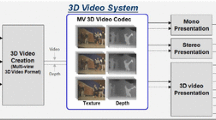Abstract
A comparative study of low complexity motion estimation algorithms is presented. The algorithms included in the study are the 1-bit transform, the 2-bit transform, the constrained 1-bit transform and the multiplication free 1-bit transform which are using different motion estimation strategies compared to standard exhaustive search algorithm-mean absolute difference or similar combinations. These techniques provide better performance in terms of computational load compared to traditional algorithms. Although the accuracy of motion compensation is only slightly lower comparing to the other techniques, results in terms of objective quality (peak signal-to-noise ratio) and entropy are comparable. This fact, nominates them as suitable candidates for inclusion in embedded devices applications where lower complexity translates to lower power consumption and consequently improved device autonomy.


Similar content being viewed by others
Abbreviations
- 1BT:
-
1-bit transform
- 2BT:
-
2-bit transform
- C-1BT:
-
Constrained 1-bit transform
- ESA:
-
Exhaustive search algorithm
- MAD:
-
Mean absolute difference
- MSE:
-
Mean square error
- MF-1BT:
-
Multiplication free 1-bit transform
- PSNR:
-
Peak signal-to-noise ratio
References
Kuhn, P.M.: Algorithms, Complexity Analysis and VLSI Architectures for MPEG-4 Motion Estimation. Kluwer, Norwell (1999)
Fotopoulos, V., Skodras, A. N.: sMAE: an improved block matching criterion. In: Proceedings of the Fifth IEEE International Conference on Electronics, Circuits and Systems (ICECS‘98), vol. 3, pp. 519–522, Lisbon, Portugal, 7–10 Sept 1998
Huang, Y.-U., Chen, C.-Y., Tsai, C.-H., Shen, C.-F., Chen, L.-G.: Survey on block matching motion estimation algorithms and architectures with new results. J. VLSI Signal Process. 42(3), 297–320 (2006)
Koga, T., Linuma, K., Hirano, A., Lijima, Y., Ishiguro, T.: Motion-compensated interframe coding for video conferencing. In: Proceedings of NTC’81, pp. G5.3.1–G5.3.5 (1981)
Ghanbari, M.: The cross-search algorithm for motion estimation. IEEE Trans. Commun. 38(7), 950–953 (1990)
Li, R., Zeng, B., Liou, M.L.: A new three-step search algorithm for block motion estimation. IEEE Trans. Circuits Syst. Video Technol. 4(4), 438–442 (1994)
Po, L.M., Ma, W.C.: A novel four-step search algorithm for fast block motion estimation. IEEE Trans. Circuits Syst. Video Technol. 6(3), 313–317 (1996)
Zhu, S., Ma, K.K.: A new diamond search algorithm for fast block-matching motion estimation. IEEE Trans. Image Process. 9(2), 287–290 (2000)
Bhaskaran, V., Konstantinides, K.: Image and Video Compression Standards: Algorithms and Architectures. Kluwer, Norwell (1997)
Choi, K.T., Chan, S.C., Ng, T.S.: A new fast motion estimation algorithm using hexagonal subsampling pattern and multiple candidates search. Proc. Int. Conf. Image Process. 2, 497–500 (1996)
Liu, B., Zaccarin, A.: New fast algorithms for the estimation of block motion vectors. IEEE Trans. Circuits. Syst. Video Technol. 3(2), 148–157 (1993)
Wang, Y., Wang, Y., Kuroda, H.: A globally adaptive pixel-decimation algorithm for block–motion estimation. IEEE Trans. Circuits Syst. Video Technol. 10(6), 1006–1011 (2000)
Kim, J., Choi, T.: A fast full-search motion-estimation algorithm using representative pixels and adaptive matching scan. IEEE Trans. Circuits Syst. Video Technol. 10(7), 1040–1048 (2000)
Natarajan, B., Bhaskaran, V., Konstantinides, K.: Low-complexity block-based motion estimation via one-bit transforms. IEEE Trans. Circuits Syst. Video Technol. 7(4), 702–706 (1997)
Urhan, O., Erturk, S.: Constrained one-bit transform for low complexity block motion estimation. IEEE Trans. Circuits Syst. Video Technol. 17(4), 478–482 (2007)
Erturk, S.: Multiplication-free one-bit transform for low-complexity block-based motion estimation. IEEE Signal Process. Lett. 14(2), 109–112 (2007)
Erturk, A., Erturk, S.: Two-bit transform for binary block motion estimation. IEEE Trans. Circuits Syst. Video Technol. 15(7), 938–946 (2005)
Hu, W., Zhang, Q.: H.264 motion estimation algorithm based on video sequences activity. J. Electron. (China) 28(1), 125–128 (2008)
Acknowledgements
This work was funded by the European Union—European Social Fund (75%), the Greek Government—Ministry of Development—General Secretariat of Research and Technology (25%) and the Private Sector in the frames of the European Competitiveness Programme (Third Community Support Framework, Measure 8.3, programme ÐÅÍÅÄ, contract no. 03ÅÄ832).
Author information
Authors and Affiliations
Corresponding author
Rights and permissions
About this article
Cite this article
Vlachos, A., Fotopoulos, V. & Skodras, A.N. Low bit depth representation motion estimation algorithms: a comparative study. J Real-Time Image Proc 5, 141–148 (2010). https://doi.org/10.1007/s11554-009-0130-4
Received:
Accepted:
Published:
Issue Date:
DOI: https://doi.org/10.1007/s11554-009-0130-4




